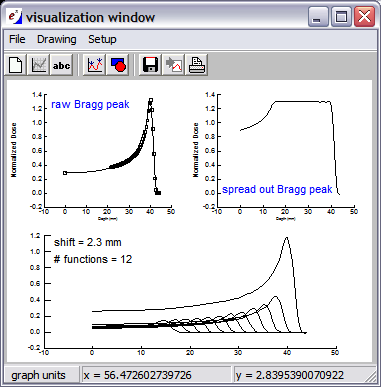The Spread-out Bragg Peak Problem

The Problem: The radiation dose resulting from a proton passing
through living tissue has a sharp, narrow peak, known as a Bragg peak.
In certain cancer therapies, the desired radiation dose should have a
broad, flat peak, where the flat section corresponds to the extent of
the tumour being treated. The problem is how to deliver the dosage
in a broad, flat distribution when the radiation is naturally
deposited in narrow Bragg peaks.
Background: Proton Beam Therapy uses protons to fight
cancer. Protons are stable, positively-charged subatomic particles
with a mass 1800 times that of an electron. Protons slow down
relatively fast when entering biological tissue, and most of their
energy is deposited, with little scatter, at the end of their path in
a peak called a Bragg peak. The depth at which the peak occurs can be
controlled by the amount of energy the protons are given by their
accelerator. The proton's dose of radiation is released in an exact
shape and depth within the body. Tissues in front of the target
receive a very small dose, while tissues adjacent to the tumor receive
virtually none. The medical value of this effect was first published
in 1947 in a paper entitled "Radiological Use of Fast Protons" by
Robert R. Wilson. Proton beam therapy has demonstrated success for
the treatment of selected tumours. More than 20,000 patients have been
treated with protons or light ions in research laboratories or
hospitals around the world.
Solution:
To begin with, we have an empirically measured Bragg peak that
describes the radiation dose along the path of the proton. We fit
this data to a smooth curve to describe the peak as a function. We
can spread the peak by adding together a weighted set of these
functions with various shifts in the independent variable. This
corresponds to using protons at different energies and intensities.
Extrema calculates the best weights to apply to each function in the set, so
that their sum results in a flat spread-out Bragg peak. This script
allows the user to explore how these functions can be used to attain a
flat distribution across the desired range, by supplying the number of
functions and their relative shift with respect to each other. The
script plots the weighted individual functions and the spread-out
Bragg peak that results from them. It also creates an output vector
containing the calculated weight values.
Click here to upload the Extrema code that performs
this analysis.
Click here to upload data for raw Bragg peak.
|



